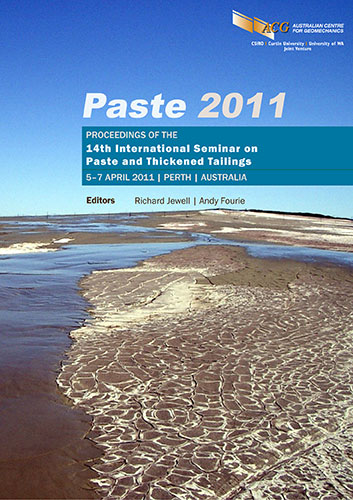Thickened tailings disposal at Musselwhite Mine

|
Authors: Kam, S; Girard, J; Hmidi, N; Mao, Y; Longo, S |
DOI https://doi.org/10.36487/ACG_rep/1104_21_Kam
Cite As:
Kam, S, Girard, J, Hmidi, N, Mao, Y & Longo, S 2011, 'Thickened tailings disposal at Musselwhite Mine', in R Jewell & AB Fourie (eds), Paste 2011: Proceedings of the 14th International Seminar on Paste and Thickened Tailings, Australian Centre for Geomechanics, Perth, pp. 225-236, https://doi.org/10.36487/ACG_rep/1104_21_Kam
Abstract:
Musselwhite Mine in Northwestern Ontario, Canada began thickened tailings disposal in May 2010. Surface disposal of thickened tailings for the 4,000 tpd gold mine was chosen following a series of studies beginning in 2002 to investigate options to expand the capacity of the tailings management area. This technology was considered most cost effective in maximising storage capacity within the existing site footprint. The elimination of a pond for closure will reduce the risk of dam failure. Further, the non-segregating tailings are expected to be relatively impervious and saturated. These characteristics will help inhibit tailings oxidation and reduce the likelihood of acid generating and metals leaching in the long term. Musselwhite Mine is currently planning to remove the sulphide minerals from the tailings stream using a flotation plant. This paper discusses the design of the thickened tailings disposal system and presents preliminary observations on tailings deposition to date. In preparation for thickened tailings disposal the tailings management area was partitioned by an internal dyke in 2008. This has allowed tailings to be ‘stacked’ using the upstream method of construction in the west cell and the east cell to serve as a water management pond. The cold climate presents a special challenge to operating the thickened tailings system as there is very little precedent experience. The design has incorporated a number of contingency measures to facilitate tailings thickening and deposition in winter. Field data have suggested that the thickened tailings system is performing very well to date. The thickening plant has consistently produced underflow at about 70% solids with minimal attention. The tailings beaches are steeper than expected. The deposited tailings are non-segregating and relatively saturated. The measured in situ dry density of the tailings is higher than expected. The performance of tailings deposition is being closely monitored.
References:
Addis, P.C. and Cunningham, E.J. (2010) Comparison of Beach Slopes from Two Centrally Discharging Tailings Storage Facilities, in Proceedings 13th International Seminar on Paste and Thickened Tailings (Paste2010),
R.J. Jewell and A.B. Fourie (eds), 3–6 May 2010, Toronto, Canada, Australian Centre for Geomechanics, Perth, pp. 255–263.
Golder Paste Technology Ltd. (PasteTec) (2007) Pre-feasibility Study for Thickened Tailings Surface Disposal and Sulphide Separation at Musselwhite Mine, Report submitted to Goldcorp Canada Ltd., January.
Golder Paste Technology Ltd. (PasteTec) (2006) Conceptual Study for Paste Surface Disposal at Musselwhite Mine, Report submitted to Goldcorp Canada Ltd., October.
Kam, S., Yaschyshyn, D., Patterson, M. and Scott, D. (2009) Thickened Tailings Disposal at Xstrata Copper Canada Kidd Metallurgical Site, in Proceedings 8th ICARD Conference, Skelleftea, Sweden, June 23–26.
Outokumpu Tecknology (2006) Goldcorp-Musselwhite Benchscale and Mini-Pilot Scale Thickener Testing, May 30–June 2.
Yalcin, T., Papadakis, M., Hmidi, H. and Hilscher, B. (2004) Desulphurization of Placer Dome’s Musselwhite Mine Gold Cyanidation Tailings, CIM Bulletin, November/December.
© Copyright 2025, Australian Centre for Geomechanics (ACG), The University of Western Australia. All rights reserved.
View copyright/legal information
Please direct any queries or error reports to repository-acg@uwa.edu.au
View copyright/legal information
Please direct any queries or error reports to repository-acg@uwa.edu.au